To be honest, I was very leery of aquafaba at first. I’m not a fan of bean-based baked goods, so the idea of using bean liquid didn’t really appeal. But I couldn’t resist the science behind it and decided to experiment. It didn’t take long for me to understand the hype behind this odd but effective egg substitute. In fact, it’s become my go to when baking vegan. To help you enjoy the magic of aquafaba, I’ve created this extensive guide with frequently asked questions, tips, and step by step pictures. And of course, it includes the basics on how to make aquafaba, with a quick recipe!
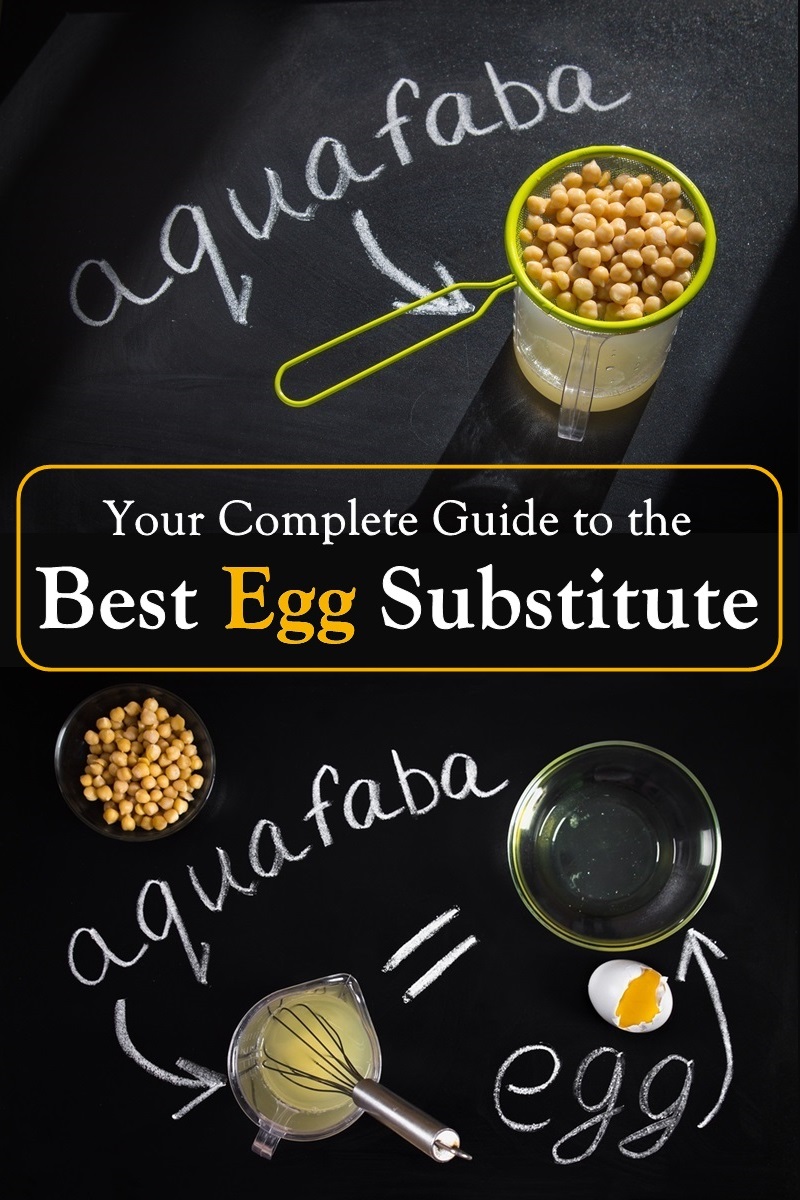
How to Make Aquafaba & FAQs for this Vegan Egg Substitute
Eggs are not dairy, so some of you might be wondering why I am covering this egg substitute here on Go Dairy Free. First, eggs are the most common secondary allergen for people with milk allergies. Second, many dairy-free consumers are also vegan or like to experiment with plant-based options. Third, you might need to bake for someone who is on an egg-free diet. Fourth, sometimes you just run out of eggs! All combined, it means that a lot of Go Dairy Free viewers need or want egg-free options. And this is one of the best egg substitutes I’ve tested.
Aquafaba FAQs
What is Aquafaba?
It’s the viscous water in which legumes, like chickpeas, have been cooked. It’s often referred to as “bean liquid” or “bean water.” During the legume cooking process, proteins, carbohydrates, and other water soluble plant solids migrate into the cooking water. It results in a thick, slightly gelatinous liquid that has properties similar to egg whites.
How Do I Make My Own Aquafaba from Scratch?
Rinse 1 cup dry chickpeas. Place them in a large bowl, cover with water, and let soak for 8 hours or more. Drain and rinse the chickpeas, and place them in a medium saucepan. Add 3 cups water and bring the chickpeas to a boil. Reduce the heat and simmer for about 45 minutes. Skim any foam that forms. Turn off the heat, and let the chickpeas sit for 1 hour. Strain the liquid (aquafaba) into a container and let cool. Refrigerate the aquafaba. It will set up more as it cools. This makes at least 1 cup of aquafaba. If it is too thin, see below. You can use the chickpeas in another recipe.
Do I Have to Make My Own Aquafaba?
A lot of people swear by the process of cooking their own beans. They say that the resultant aquafaba is superior. But many use the bean liquid from canned beans with stellar results. In other words, the bean liquid from canned beans works just fine.
Can I Use the Aquafaba from Any Beans?
Technically, you can use the liquid from any legume. Chickpeas have become the default aquafaba legume for a few reasons. One is that the liquid from cooked chickpeas is clear with a yellow tinge. It looks very similar to egg whites, and does turn white when whipped. Many other beans have murky or a more deeply colored bean liquid. Chickpea liquid also tends to be relatively reliable in thickness, and often produces the best results when whipped. Finally, many of us just love chickpeas and always have some on hand. But when I made the Chipotle Black Bean Burgers recipe in my cookbook, Eat Dairy Free, for example, I just use a little of the leftover black bean liquid as a binder. The color isn’t an issue in that recipe, so there is no reason to open a whole can of chickpeas!
What If the Aquafaba is Too Thin?
If the bean liquid appears too watery, you can reduce it on the stove top. Simply simmer it in a pan over medium-low heat until it has thickened to more of a runny egg white consistency. This is cooked liquid, so there is no harm in cooking it a little more. But let it cool completely before continuing with your recipe.
Does it Taste Beany?
The first time I whipped chickpea aquafaba I was scared because it smelled very beany. The taste was a touch pronounced, but it seemed to mellow and meld nicely once sweetened or added to a recipe. No one noticed any beaniness in the aquafaba meringues I made, which contained just chickpea liquid, sugar, and vanilla. But the flavor could vary based on the type of bean liquid that you use and if it is salted or unsalted.
How Much Aquafaba Equals 1 Egg?
Use a full 3 tablespoons of aquafaba per 1 large egg. Use 2 tablespoons of aquafaba per 1 large egg white.
Can I Use Aquafaba to Replace Eggs in Any Recipe?
It has emulsifying, binding, thickening, and even rising properties. So bean liquid seems invincible as an egg substitute. And it does work well in almost all baked recipes, including as an egg wash. But it isn’t the best stand-alone egg substitute for scrambles, quiches, egg salads, or other applications where egg yolks are integral. But it can still be a helpful component in some of these recipes. For example, I use aquafaba in the Impossible Vegan Quiche recipe in my cookbook, Eat Dairy Free, but I don’t rely on it alone for the structure.
Aquafaba does work in recipes that call for several eggs or egg whites, but the results can vary. They don’t have as tight of a structure as eggs so things like angel food cake won’t be quite as fluffy.
Do I Have to Whip Aquafaba?
You only need to whip it if your recipe calls for whipped egg whites. Otherwise, you can use the bean liquid as is. If you do need to whip the egg whites, see my step-by-step visual and recipe below for How to Make Aquafaba.
Should I Use Salted or Unsalted Beans?

Do I Need to Refrigerate the Aquafaba First?
I was once told to refrigerate it first, but have never seen any difference in the results. Room temperature chickpea liquid will still whip nicely and should work in recipes just fine.
Help, I used Aquafaba and my Cake / Muffins / Cupcakes Collapsed! What happened?
As mentioned above, the structure of bean liquid doesn’t set up quite as firm or quickly as eggs. So if your baked goods rise too quickly or too boisterously, or without enough other binders, they can essentially “pop” and collapse.
Look at your baked good half way through baking (through the glass). If it simply isn’t rising, you might need a little added leavener. If it has risen nicely, but then sinks once done, you’ve had a collapsing issue. In these cases, reducing the leavener and/or using more binding ingredients can help to solve the problem. This issue is even more common with gluten-free baked goods, which tend to be more fragile.
How Can I Store Leftover Aquafaba?
It can be refrigerated in an airtight container for at least a few days. But many people opt to freeze the leftover bean liquid for extended storage. I recommend creating 1 tablespoon (measured) frozen cubes. This way you can defrost as may cubes as you need at a time: 2 tablespoons per large egg white, 3 tablespoons per whole large egg.
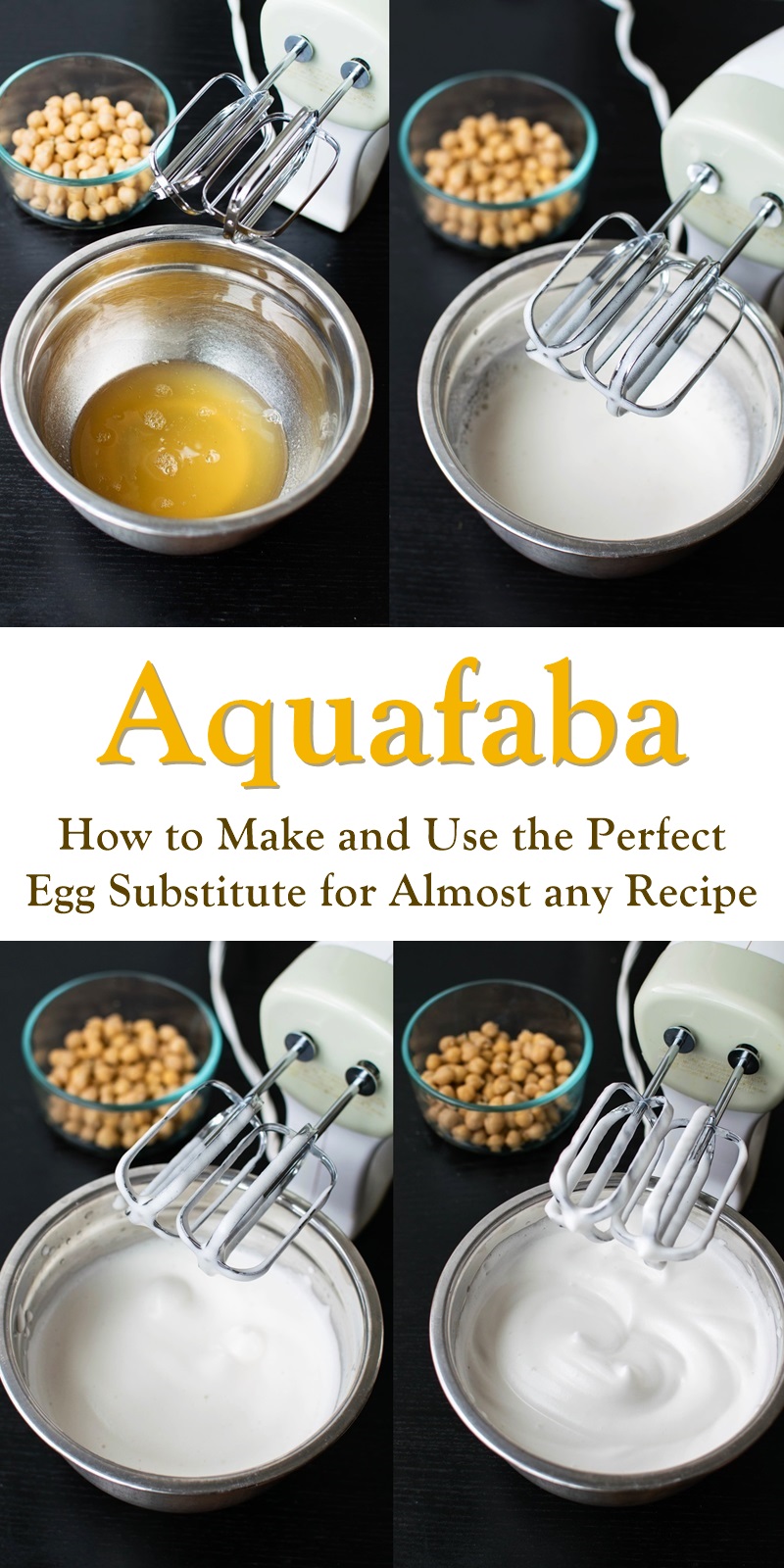
How to Make Aquafaba (Step by Step Pictures)
As mentioned above, you don’t need to whip aquafaba for all recipes. When asked how to make aquafaba, I usually just respond “drain, measure, and add to your recipe!” But when your recipe calls for whipped egg whites, you must whip the aquafaba.
Bean liquid takes longer to whip than egg whites, so it requires a little patience. If you have a stand mixer, this is a good time to use it. Drain a can of chickpeas into a mixing bowl. This should yield about 1/2 cup of aquafaba. If your recipe calls for cream of tartar, you can add it now.
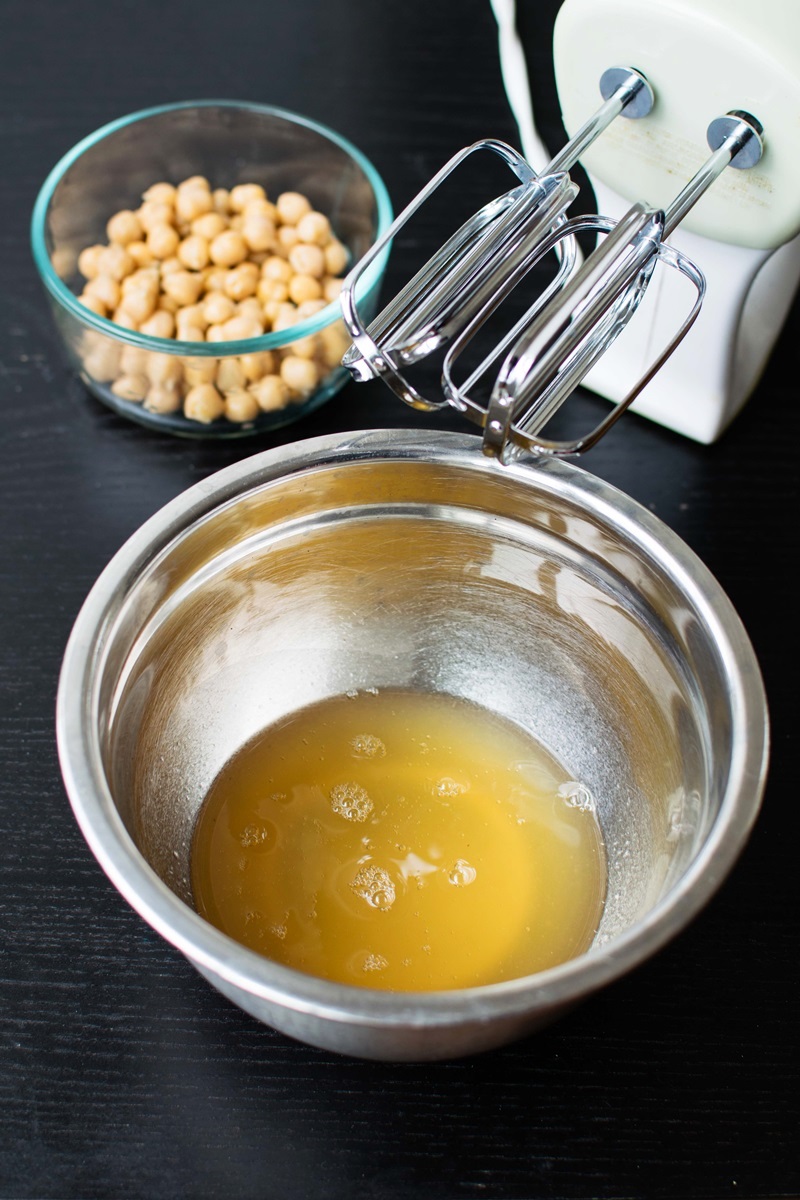
Begin mixing on low speed. It will become foamy within the first minute. Contrary to belief, bean liquid was found to be extremely low in saponins. So what causes it to foam isn’t completely known.
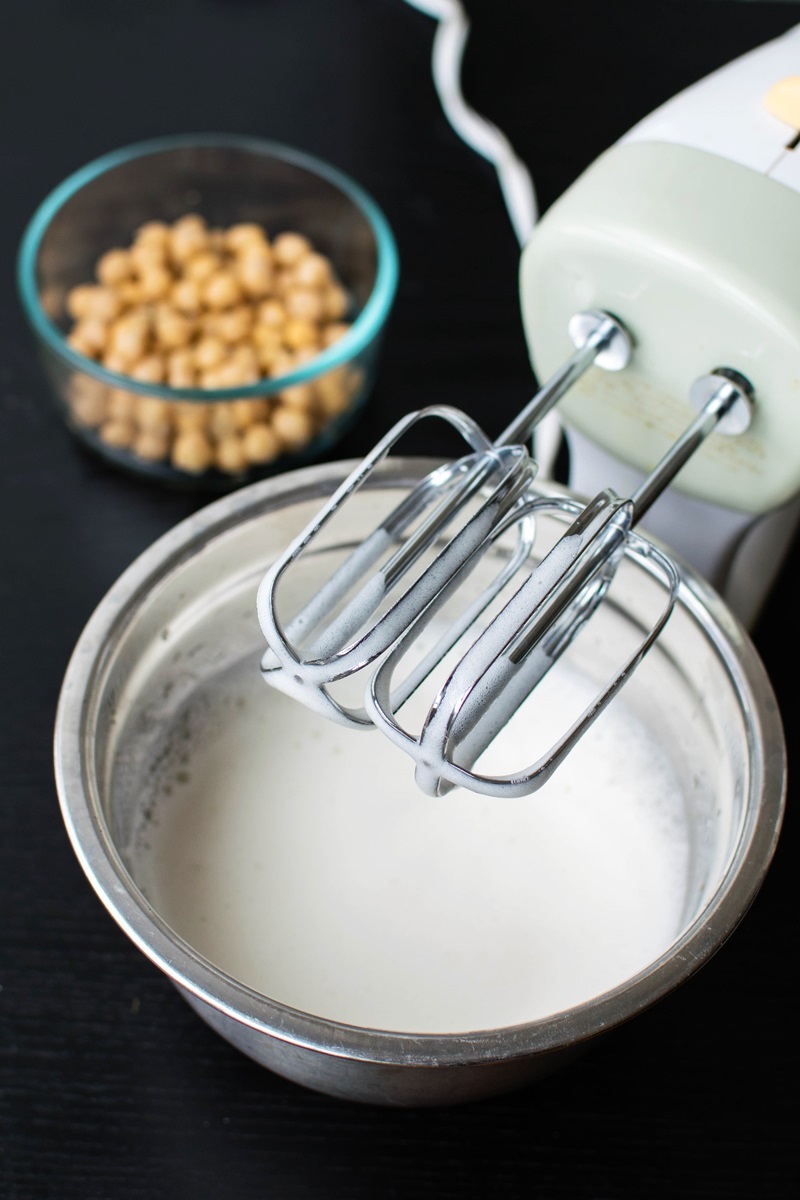
At 3 to 4 minutes, it should start to look just a little thicker, almost like a fluid cream but not as rich. You can turn the mixer speed up to medium, at this stage.
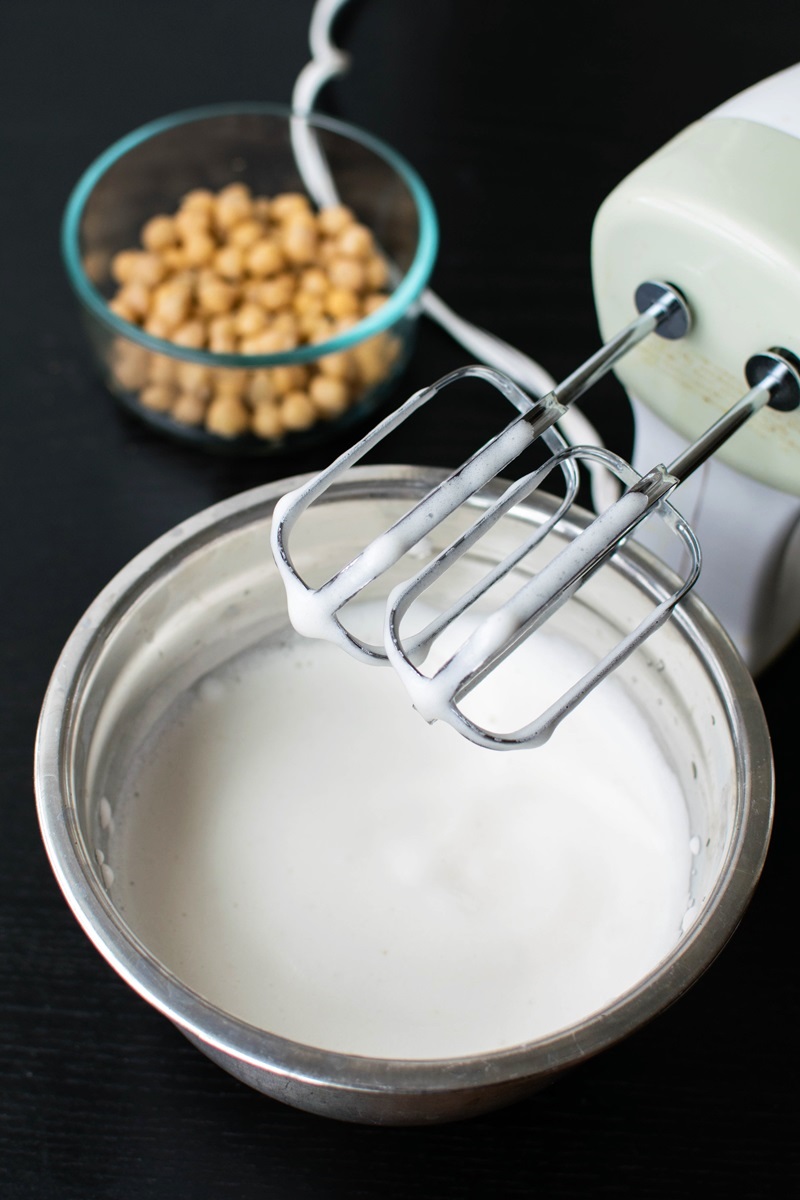
At 5 to 6 minutes, you will probably see it thicken to the soft peak stage. When you remove the mixer, soft little mounds will remain.
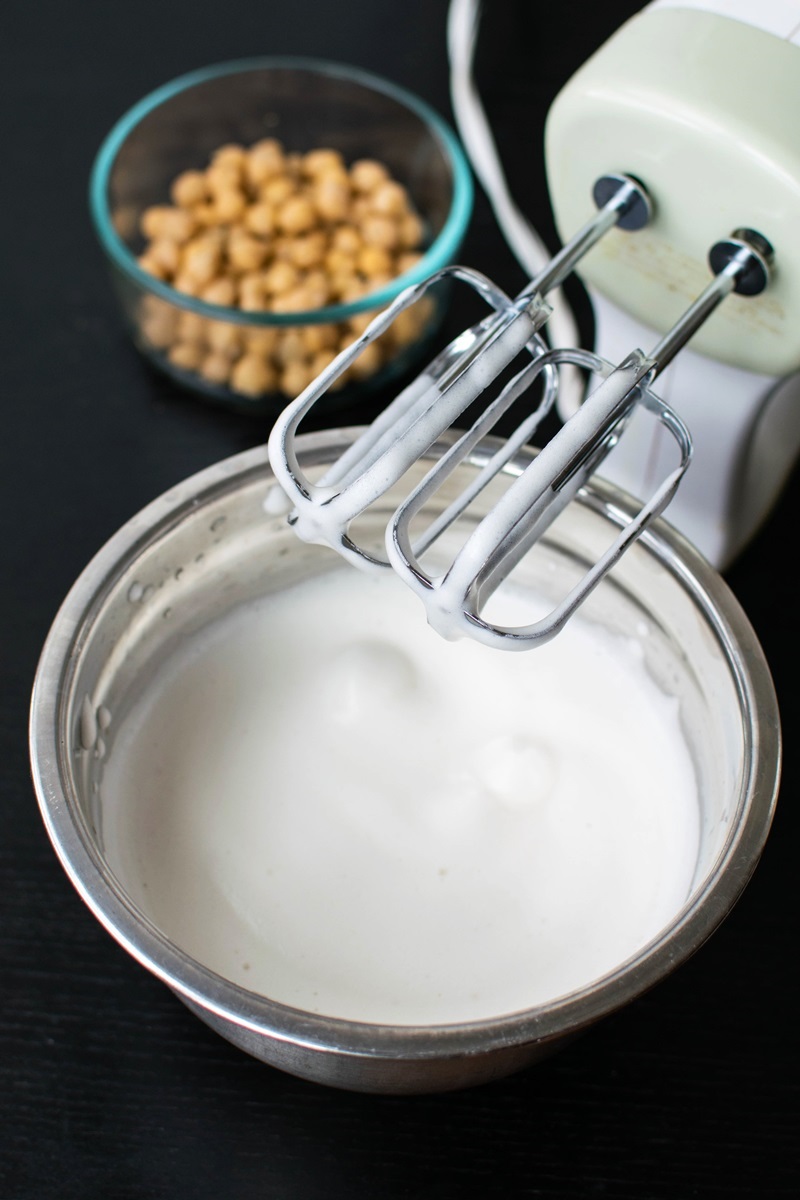
At 7 to 10 minutes, it will finally reach the firm, semi-stiff, or stiff peak stage. If your starting bean liquid was a little thin, these stiff peaks might not seem quite as stiff as whipped egg whites. But it still works well in recipes. As a benefit, aquafaba doesn’t overwhip as easily as egg whites. So it’s okay to whip a little longer if your goal is the stiffest peaks possible.
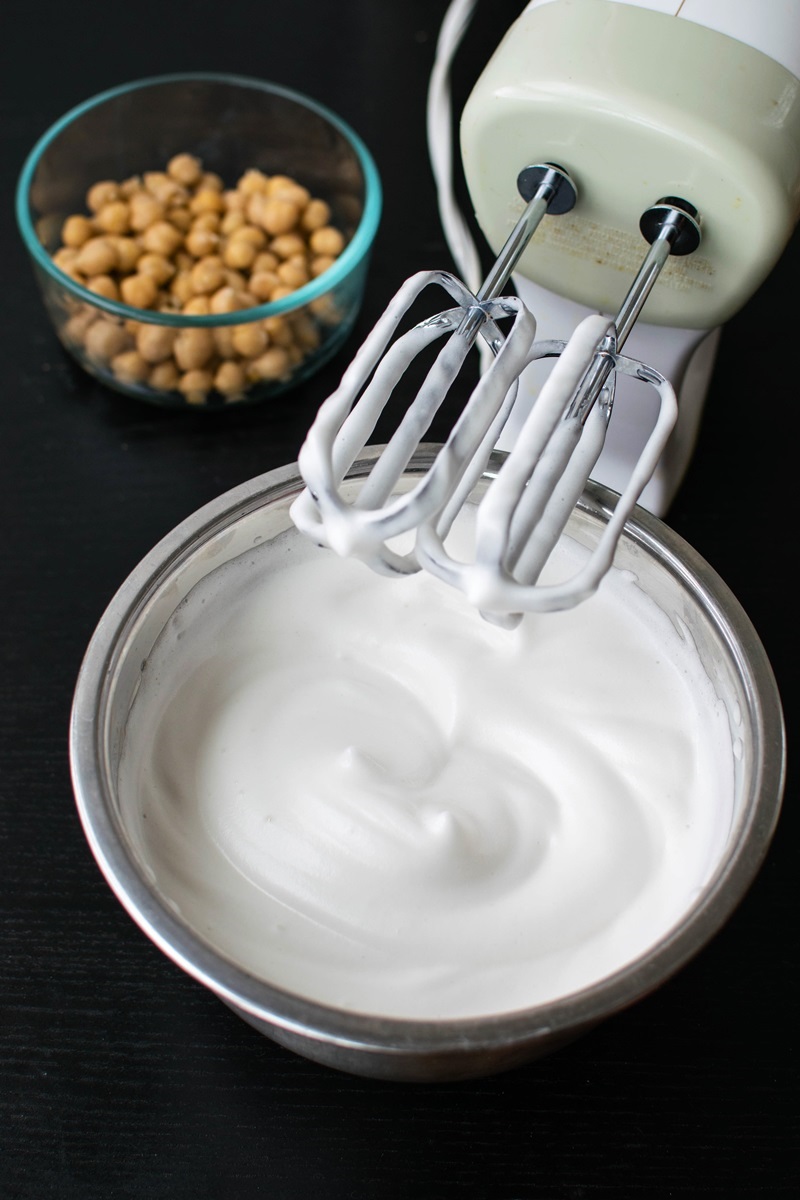
At this point, you can follow your recipe and fold the “whites” into your recipe or blend in other ingredients. Here I blended in sugar and vanilla bean paste to make meringues.
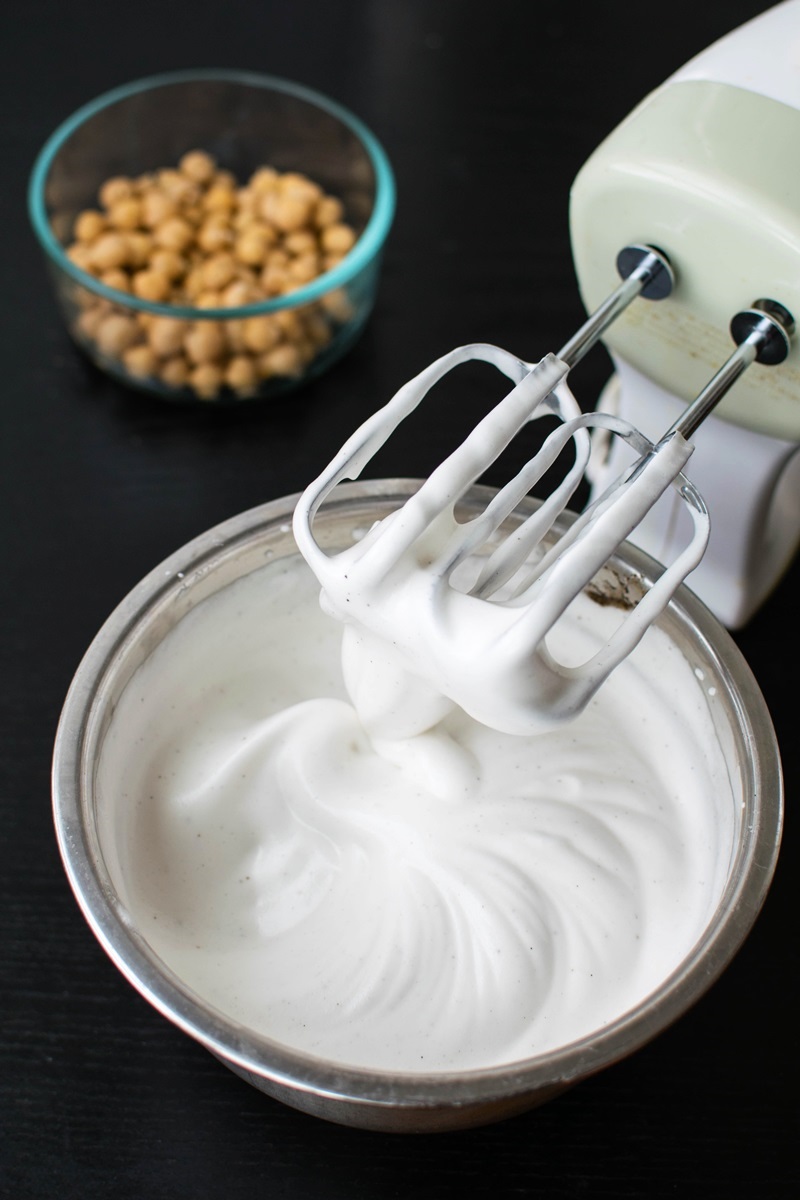
Special Diet Notes: Aquafaba
By ingredients, this recipe is dairy-free / non-dairy, egg-free, gluten-free, grain-free, nut-free, peanut-free, soy-free, vegan, plant-based, vegetarian, and top food allergy-friendly.
- 1 (15-ounce) can chickpeas (see post above about other legumes and home cooked chickpeas)
- Drain the chickpea liquid into a container. Use 3 tablespoons of the liquid per whole large egg called for in your recipe. Use 2 tablespoons of the liquid per large egg white called for in your recipe.
- Store leftovers in an airtight container in the refrigerator or freeze to use later.
- Drain the chickpea liquid into a mixing bowl. Reserve the chickpeas to enjoy in another recipe.
- If your recipe calls for cream of tartar, add it now.
- Begin mixing the liquid on low speed with a hand mixer or stand mixer. It will start to foam very quickly. After a few minutes it will begin to thicken.
- Optionally turn the mixer up to medium speed. It will continue to thicken, and will usually reach the stiff peak stage at about 7 to 10 minutes.
- Now use the whipped aquafaba in place of whipped egg whites in your recipe. This usually means folding it into your batter, or mixing in additional ingredients.
A Dozen Vegan Recipes Using Aquafaba
- Classic Vegan Waffles
- Basic Vegan Sugar Cookies
- Gingerbread Pumpkin Pie
- Slow Cooker Vegan Pecan Loaf
- Gingerbread Cupcakes
- Tunnel of Fudge Cake
- Horchata No-Churn Vegan Ice Cream
- Air Fryer Onion Rings
- Crackly Brownies
- Vegan Tres Leches Cake
- Peanut Butter Blondies
- Chai Spiced Pumpkin Cake
More Great Egg-Free Resources
Go Dairy Free: The Guide and Cookbook (egg-free options for every recipe)
Eat Dairy Free: Your Essential Everyday Cookbook (egg-free options for every recipe)
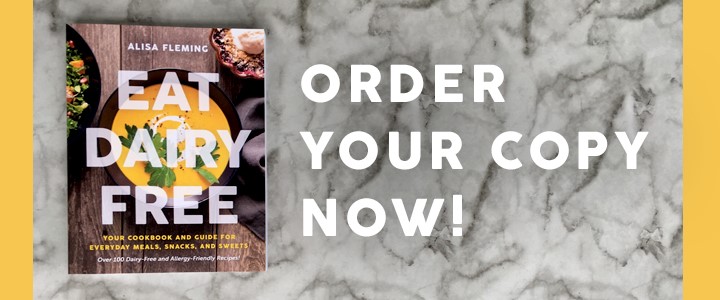


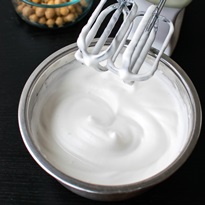
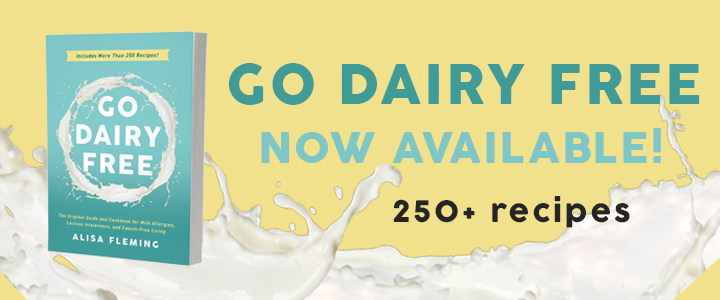
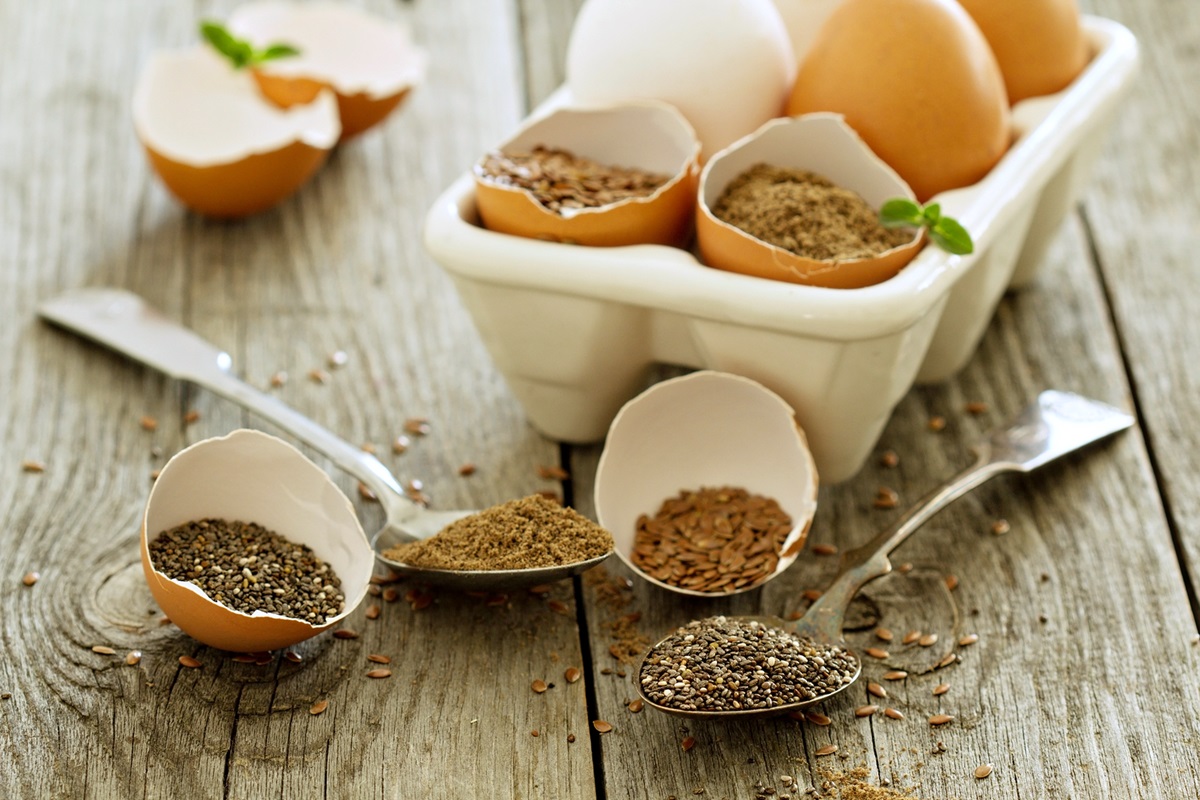
58 Comments
Are they like egg whites in the way that they will they not whip up if there is any fat in the mixer?
I haven’t tried adding fat, like oil, that’s a good question. There definitely are some chemical differences between aquafaba and egg whites. Like aquafaba takes much longer to whip and doesn’t overwhip as easily as egg whites. It also doesn’t produce quite as fluffy of items when baked. I have added extract without a problem, but can’t say for sure on residual fat. If you are having trouble getting it to whip up, then this could be an issue. But they do take MUCH longer to whip.
Really well written piece, thank you. I particularly like the science edge to help understand it. I’ve found that when I use aquafaba my cakes rise in the oven but drop considerably when cooling. Does aquafaba coagulate when heated in a similar way to eggs? Just trying to work out what is going on so I can adjust as necessary. Thanks
They can collapse, if you were doing a recipe where you whipped them to add more air and were over or under whipped. Aquafaba won’t produce as fluffy a result as egg whites will either. But the culprit might not be your aquafaba specifically. Cakes without eggs and dairy have less structure and elasticity. Even though aquafaba is a great substitute, it still doesn’t provide as much structure as eggs. When a cake rises, if it rises too quickly, and doesn’t have enough structure, it can “burst” and collapse. You don’t see it actually burst, but that’s what’s happening. The structure breaks and the cake falls. This can happen with any baked good that is over-leavened, but the balance is even trickier with vegan baked goods. If even a little too much baking powder and/or baking soda is used, then you can have a sunken cake to some degree. Also, if you live at any level of high altitude (even over 2000 feet) this issue can be exacerbated. So I would look to the leavener first, and reduce if it looks like the possible culprit.
Thank you for your reply, I think I need to keep practicing and accept that my vegan cakes won’t be as risen and structured as egg based ones. They’re always delicious anyway!
Has anyone made aquafaba meringues with sugar substitute?
I haven’t. In theory, it should work fine, so long as there isn’t a chemical reaction with the type of sugar alternative used. I would personally try a pure stevia powder first, since you wouldn’t need to add much.
Thank you for your sharing. This worked great in my recipe!
I hope it is as easy as you make it sound as I have my daughter and her vegan boyfriend coming for Christmas and I need a vegan and gluten free Christmas cake! I’ve been making gluten free for years but couldn’t think how to substitute for the eggs in a proper Christmas cake.
I hope it works out well for you Julie! Aquafaba has worked great for us in countless recipe tests. Please keep in mind that gluten-free + vegan does equal much less structure and differences in texture. Aquafaba is the best replacement we’ve found for structure, but it still is a smidgen less stable than eggs. Since you are used to baking gluten-free, though, it should work well. Also, aquafaba rises a little less than eggs when baking. If needed, you might want to increase the baking powder just a little. It depends on your recipe though.
Can’t wait to try this .. off to make my fave European cake recipe which can now be vegan !
Will let you know how it goes, thanks for all of your tips x
Happy to help! I hope it works out well for you.
If I whipped too much bean juice, then left it in the fridge, would it turn thin and watery again and have to be re-whipped?
It won’t turn to liquid, but still might need rewhipping a bit.
Hi there! I’m trying to veganize a cake recipe, it calls for creaming the butter and sugar and then adding in a carton of egg whites, should I just pour the aquafaba straight? I’m doing so much research online and some people are saying to whisk it a bit until it gets foamy, while others are saying to whisk it to stiff peaks, but that doesn’t make sense due to the original recipe instructions, any help would be appreciated!
Does the recipe call for you to whip the egg whites? If so, I would whip the aquafaba. If not, then they don’t need you to add air into the recipe. Whipping the aquafaba is like whipping egg whites, only it takes much longer to get stiff peaks to form. Keep in mind, if you are replacing that many eggs, aquafaba is probably the best substitute, but the results will still be very different. It sounds like an angel food style cake, which comes out tall and fluffy. I haven’t made one myself, but have seen photos of aquafaba angel food cake, and it doesn’t come out as tall and light.
Hi. I would like to ask for an advice please. In recipe it says to whisk 4 egg whites then gradually whisk in icing sugar and then one by one add egg yolks. So how do I replace egg yolks please? Or do I just whisk up amount which equals to for whole eggs and skip yolks? .. Hope you understand what I’m trying to ask 😊 thank you.
Egg yolks are tricky. I would personally just use aquafaba for all, and use 3 tablespoons of it per egg (3/4 cup for 4 eggs). I’m assuming your recipe uses some type of butter alternative. If not, I might add just a touch of buttery spread. Like I might add 1/2 tablespoon buttery spread to my measuring cup, then add the aquafaba to 3/4 cup. It might help to add richness and a little more emulsification from the lecithin typically used in this product. I haven’t made the recipe you are speaking of, so it’s hard to say without testing. But based on the information you’ve provided, that’s what I might try.
Hi, thank you for this helpful tutorial!
Unfortunately due to allergy cross contamination concerns I can’t use canned chick pea liquid, I had to make my own from dried garbanzos. I boiled it down to what seemed to be the consistency of dish soap while hot but now that it’s at room temperature it’s more viscous, like canned gravy! Do you think I need to thin it or can I whip it as is?
Thanks!
You can always add more liquid if needed – I would try whipping it.
I first heard of Aquafaba on the British baking show. I didn’t realize you could use it in so many ways. Do you think it would work for making homemade marshmallows?
If the marshmallow recipe you’re using calls for egg white, then yes, I believe it will work. The results might be a little different, but should have the same vibe.
In your opinion, would aquafaba substitute well in pudding, in which the recipe calls for egg yolks? If not, would something else work better? Thanks in advance!
See this post on egg subs -> https://www.godairyfree.org/food-and-grocery/how-to-substitute-eggs-vegan
I had my mind made up on using “flex eggs” in my vegan cookie recipe. I’ve literally stumbled across Aquafaba for the first time about an hour ago…and my mouth dropped open! I have a few questions for you:
(1) Is there any added benefit to using the liquid from organic garbanzo beans?
(2) Does it matter whether the liquid is drained BEFORE or AFTER the garbanzo beans have been cooked?
I haven’t found any difference between aquafaba from organic and conventional chickpeas, aside from the organic factor. Aquafaba is the liquid that is created from cooking the chickpeas. So in cans, you are using the cooked chickpea liquid. If you make it at home, from dry chickpeas, aquafaba is the cooking liquid from after the cooking process. I hope that helps!
Oops…I see that you’ve already answered my second question. Please omit.
any consistent effect on cooking times with aquafaba vs eggs in a typical muffin recipe?
Not that I’ve noticed.
Can I use the liquid from chickpeas sold in glass jars?
I’ve never seen beans sold in glass jars, but yes, technically, it should work the same. You can even use the cooked down liquid from home-cooked beans.
This is the single most helpful “how to” I’ve come across since adopting a plant-based lifestyle. Enormously useful, comprehensive, and easy to understand. Thank you!
I have been making the keto bread with 1 cup of boiling water, 1 1/4 cups of almond flour, 2 t baking powder, 2 t cider vinegar, 5 T psyllium husk powder, and it calls for 3 egg whites….however, when you add the boiing water it seems to start cooking the egg whites and causes the bread to taste eggy which is awful….so I now have bread in the oven I made with Aquafaba subsitute…I think I did make a BIG mistake though….I beat the bean water a little first before adding it to the flour and I measured it AFTER I beat it…so I think I will be off on the amount I added being to little…if they do not come out I am going to go back and make another batch and measure before beating it, if I do even beat it..wish I had read these instruction here before I started, but just like me to do then research..:-D this is a great article and very helpful…excited that I found it.
Glad I can help and I hope you get it to work Brenda!
I’m going to make a nutloaf for friend’s that are vegan, I stumbled upon your site so I’m going to replace the egg with 3T chickpea water. Fingers crossed.
It should work! Good luck – I hope it is delicious!
I keep saying I’m gonna play around with Aquafaba but then chicken out. Now that I have this, there’s no excuse!
It isn’t spot on for eggs, but definitely works well and is fun. You should try it Lorie!
I’ve been wondering how to make this! Thanks for the tips! It sounds a lot easier than I thought!
It really is! Just patience required in whipping 🙂
Pingback: How to Substitute Eggs: 10 Easy Vegan Swaps for Every Recipe